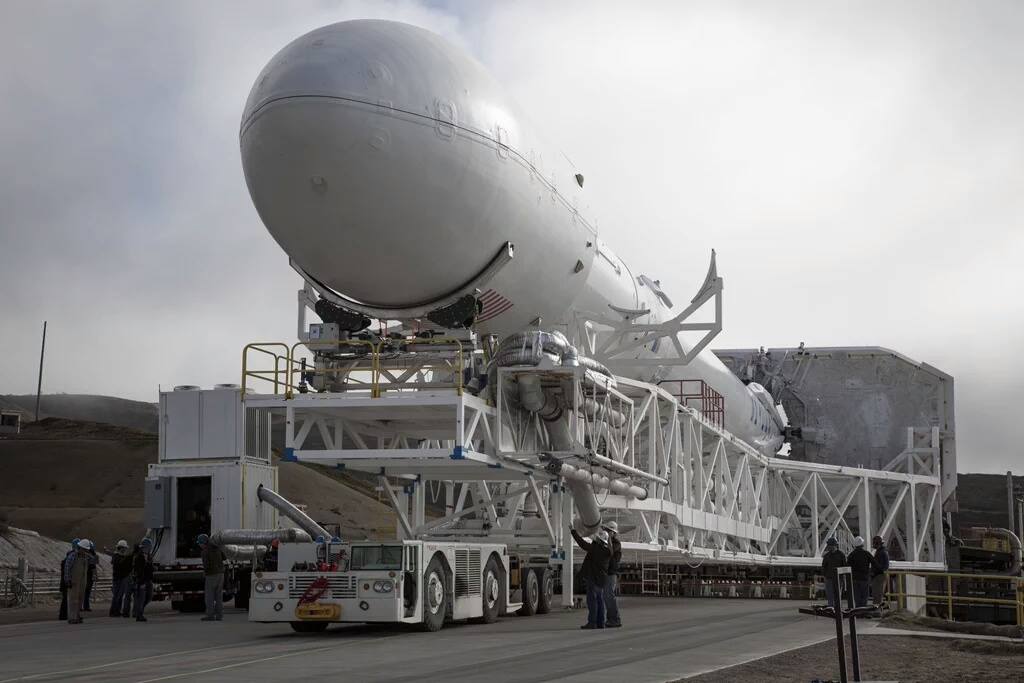
Less than 28 months since its maiden voyage—which delivered Canada’s low-Earth orbiting Cascade, SmallSat and IOnospheric Polar Explorer (CASSIOPE) aloft, back in September 2013—SpaceX stands ready to close out a remarkable chapter in its short history tomorrow (Sunday), as it stages the last launch of its “standard” Falcon 9 v1.1. Slated to boost the Jason-3 ocean altimetry mission from Space Launch Complex (SLC)-4E at Vandenberg Air Force Base, Calif., during a 30-second “window”, which opens at 10:42:18 a.m. PST (1:42:18 p.m. EST), the v1.1 will wrap up a run of 15 missions, all but one of which have proven successful and delivered their primary payloads into the desired operational orbits. As well as marking SpaceX’s 21st overall flight by a member of the Falcon 9 family, the completion of tomorrow’s mission will pass the baton to the Upgraded Falcon 9, which debuted last month. Launching Jason-3 also opens the floodgates to an ambitious 2016 for the Hawthorne, Calif.-based launch services company, which supported a successful Static Fire Test of its newly-returned Upgraded Falcon 9 on Friday and hopes to fly its inaugural Falcon Heavy by mid-year.
The two-stage Falcon 9 v1.1, which stands 224 feet (68.5 meters) tall and is equipped with uprated Merlin 1D engines, was billed as delivering a 56-percent thrust uplift at sea-level over the Merlin 1Cs aboard its Falcon 9 v1.0 predecessor. The latter supported five successful missions from June 2010 until its final flight in March 2013, which delivered SpaceX’s second Commercial Resupply Services (CRS-2) Dragon cargo mission to the International Space Station (ISS). The Merlin 1D powerplant—which underwent full-flight-duration test-firings at SpaceX’s facility in McGregor, Texas, in summer 2012—was capable of 1.3 million pounds (590,000 kg) of thrust from its nine first-stage engines at liftoff, representing a 200,000-pound (90,000 kg) increase over the capabilities of the Falcon 9 v1.0. Equipped with four deployable landing legs, the first stage was also intended to eventually alight on an oceanic Autonomous Spaceport Drone Ship (ASDS) or at specialized landing pads, close to its launch site.
Over its 28 months of operational life, and including tomorrow’s flight of Jason-3, the v1.1 would support 15 missions, only one of which—the catastrophic high-altitude failure of the CRS-7 Dragon, last 28 June—met with calamity. Its inaugural mission in September 2013 successfully inserted Canada’s CASSIOPE science satellite into low-Earth orbit, after which the v1.1 supported its first foray to Geostationary Transfer Orbit (GTO) on 3 December, boosting the SES-8 communications satellite aloft on behalf of the Luxembourg-based SES satellite services provider. A month later, in January 2014, SpaceX near-duplicated the feat, by delivering the Thaicom 6 satellite into GTO, before resuming ISS-bound Dragon operations with the CRS-3 mission in April. The latter represented the first v1.1 to boast landing legs and it achieved a “controlled” splashdown in the Atlantic Ocean.
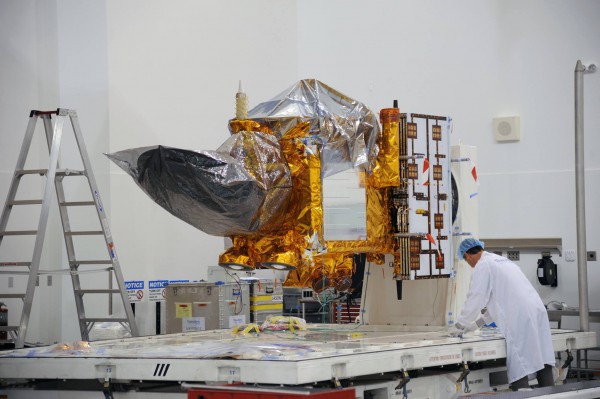
A successful, personal-best-beating 2014 followed, with SpaceX securing a grand total of six missions by year’s end. The long-delayed launch of six OG-2 satellites for Orbcomm, which eventually took place on 14 July, saw the returning first stage successfully deploy its landing legs and accomplish a “soft” splashdown, although hull integrity was breached and it was decided not to recover the hardware. Two more GTO-bound missions in the summer carried the AsiaSat-8 and AsiaSat-6 satellites aloft, with the CRS-4 Dragon following in late September, wrapping up four SpaceX missions within a ten-week spell.
Last year, 2015, started well, with the first deployment of the ASDS to support the landing of the v1.1 first stage from the ISS-bound CRS-5 Dragon mission. Although the stage reached the deck of the ASDS—a remarkable technical accomplishment in its own right—it impacted at a 45-degree angle and exploded, due to the premature exhaustion of hydraulic fluid in the grid-fin control system. A second attempt during the CRS-6 Dragon mission in April came closer to success, but “wobbled” during its final descent to the ASDS, due to excessive lateral velocity, caused by a stuck throttle valve, and toppled over shortly after touching down. By this stage, the v1.1 had already delivered other payloads aloft: a pair of GTO-bound missions were launched in March and late April and SpaceX successfully delivered the Deep Space Climate Observatory (DSCOVR) to the L1 Lagrange Point, in February. The latter represented SpaceX’s first foray beyond Earth orbit.
Although plans were afoot to transition from the v1.1 to its successor, the Upgraded Falcon 9—with an expectation that the latter would debut in summer 2015, delivering the SES-9 communications satellite to GTO—the move occurred far more quickly than might have been thought. On 28 June, the CRS-7 Dragon was lost at high altitude, when a failed strut doomed the 19th Falcon v1.1 in a catastrophic structural break-up. Beginning with the Return to Flight (RTF) on the OG-2 mission, it was intended that all future flights would employ the Upgraded Falcon 9, with the exception of the Jason-3 ocean altimetry mission, which had already been earmarked for a v1.1 slot.
As outlined by AmericaSpace’s Mike Killian, the Flight Readiness Review (FRR) was concluded on 8 January, clearing the final milestone ahead of a problem-free Static Fire Test of the v1.1’s nine Merlin 1D engines—which are configured in an octagonal pattern, with a circle of eight engines and a ninth in the center—on 11 January. The test, which took place at 5:35 p.m. PST (8:35 p.m. EST), ran the engines for 7 seconds and preliminary data appeared favorable, according to a SpaceX tweet. Following the Static Fire Test, the Jason-3 satellite’s batteries were charged and, encapsulated within its bulbous Payload Fairing (PLF), it was install atop the v1.1 in a horizontal configuration at SLC-4E. The Launch Readiness Review (LRR) took place yesterday (Friday, 15 January), clearing the final milestone and setting all teams in motion for an opening launch attempt on Sunday.
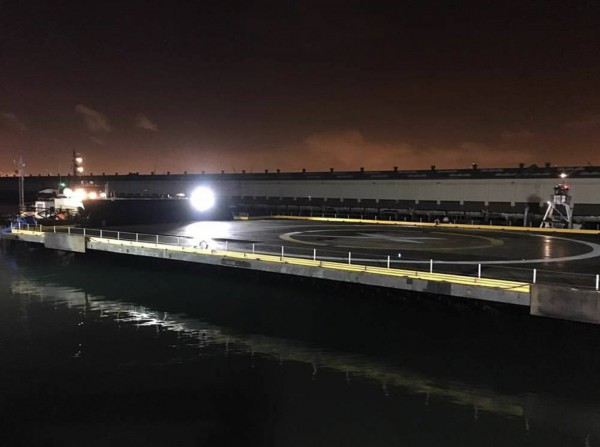
Although the first stage from the Jason-3 mission is targeted to attempt a controlled landing, AmericaSpace was recently informed that the “next few missions”, both v1.1 and Upgraded Falcon 9s, will be recovered aboard the ASDS. “For Jason-3, we didn’t receive environmental approval for a land landing in time for the launch, so we are doing it on the drone ship,” we were advised by SpaceX, “plus this is good practice for future high-velocity launches that don’t enough of a delta-velocity budget to return to the launch site.”
Sunday’s launch will be only the second-ever flight of a Falcon 9 out of Vandenberg Air Force Base, with both the first and last missions of the v1.1 having originated from Space Launch Complex (SLC)-4E at the mountain-ringed site, which lies to the northwest of Lompoc, Calif. In fact, then CASSIOPE rocketed to orbit in September 2013, it marked the end of an eight-year hiatus of flights from SLC-4E, which had reverberated to the sound of 68 previous launches over the preceding four decades. Originally known as “PALC2-4”, it was originally one of two Vandenberg complexes for Atlas-Agena launches and first supported the flight of a KH-7 reconnaissance satellite in August 1964. Twenty-seven Atlas-Agenas flew from PALC2-4, until the pad was deactivated in June 1967. It re-entered service four years later and 22 Titan IIID boosters flew from the newly-renamed SLC-4E from June 1971 until November 1982, after which its next resident was the Titan 34D, which accomplished seven missions from June 1983 through November 1988. This run of launches included an explosion in April 1986, just months after the Challenger disaster. More recently, the pad supported the final generation of Titan rockets—the Titan IV—and 12 missions were flown between March 1991 and October 2005, pushing SLC-4E’s tally to 68 launches. Following extensive upgrades by SpaceX in 2011-2013, and with CASSIOPE now behind them, Sunday’s launch will mark the 70th flight out of SLC-4E.
Based upon the flight profile out of Vandenberg for the CASSIOPE mission, it can be anticipated that the Jason-3 launch campaign will commence by about T-13 hours and 30 minutes, when the v1.1 systems will be powered-up, ahead of the opening of the 30-second “window” at 10:42:18 a.m. PST (1:42:18 p.m. EST). Approximately 3 hours and 50 minutes before T-0, the loading of liquid oxygen into the Falcon 9’s tanks will commence and all propellants should be aboard the vehicle shortly thereafter, entering a “topping-off mode”, as boiled-off cryogens are continuously replenished until close to launch time.
A perfect weather situation, with a 100-percent probability of acceptable meteorological conditions, is anticipated for Sunday’s launch attempt, according to the 30th Weather Squadron at Vandenberg. The Terminal Count will be initiated at T-10 minutes and during this final phase of the countdown the final v1.1 will transition to internal power and assume primary control of vehicle critical functions. At T-2 minutes, the SpaceX Launch Director and the Air Force’s Range Safety Officer (RSO)—the latter of whom carries responsibility to destroy the vehicle in the event of a major accident during ascent—will declare their readiness to support the launch. At 60 seconds, SLC-4E’s “Niagara” deluge system will flood the pad surface and flame trench with 30,000 gallons (113,500 liters) of water per minute to suppress acoustic energy radiating from the Merlin 1D engine exhausts.
Entering the final minute, the v1.1 propellant tanks will reach flight pressure and at T-3 seconds the nine Merlins will roar to life, reaching a combined thrust of 1.3 million pounds (590,000 kg). Under computer command, their ignition sequence and start-up performance will be closely monitored and the hold-down clamps will release the vehicle from SLC-4E at T-0. Immediately after clearing the tower, the v1.1 will execute a combined pitch, roll and yaw program maneuver to establish itself onto the proper azimuth for the injection of Jason-3 into a relatively “high” low-Earth orbit, inclined 66.05 degrees to the equator, which will dip to 825 miles (1,328 km) at perigee and reach 857 miles (1,380 km) at apogee.
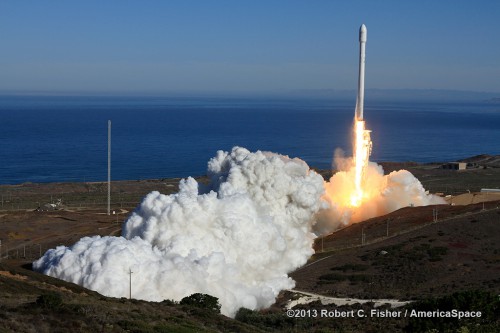
Seventy seconds into the ascent, the vehicle will surpass Mach 1 and experience a period of maximum aerodynamic stress (known as “Max Q”) on its airframe. Meanwhile, the Merlins will continue to burn hot and hard, finally shutting down at about T+170 seconds, after which the first stage will be jettisoned. It will perform a trio of boost-back, retro-propulsion and landing burns to alight on the ASDS “Just Read The Instructions”, which is positioned in the Pacific Ocean, some 173 miles (278 km) south of Vandenberg. As this dramatic landing attempt unfolds, the v1.1’s second stage—powered by a single Merlin 1D Vacuum engine, with a propulsive yield of 180,000 pounds (81,600 kg)—will continue to boost Jason-3 uphill into its preliminary orbit. During this boost, the bulbous Payload Fairing (PLF) will be discarded, exposing the 1,150-pound (525 kg) satellite to the harsh space environment for the first time. Two burns of the Merlin 1D Vacuum engine will be required to insert Jason-3 to orbit.
In parallel developments, SpaceX yesterday (Friday) conducted a Static Fire Test of the nine Merlin 1D+ engines on the first stage of its newly-returned Upgraded Falcon 9, which benefits from “densified” cryogenic propellants and an enhanced 33-percent performance gain, allowing for the exploitation of full, 100-percent-thrust capability. This first stage provided the initial boost towards low-Earth orbit for 11 Orbcomm Generation-2 (OG-2) satellites on 21 December, before propelling itself back from the edge of space and alighting on Landing Zone (LZ)-1 at Cape Canaveral Air Force Station, Fla. Shortly after Christmas, the somewhat charred and blackened stage was transferred to the historic Pad 39A at the Kennedy Space Center (KSC) for an already-planned series of checks, leading up to a Static Fire Test of the engines.
The historic pad—first used by the unpiloted Apollo 4 in November 1967, which also saw the debut of the mammoth Saturn V booster, and later employed by all but one of the Moon-bound Apollo manned missions and 82 flights of the Space Shuttle Program, most recently in July 2011—was handed over by NASA to SpaceX in April 2014, under the terms of a 20-year lease. A large Horizontal Integration Facility (HIF) has since been erected, astride Launch Complex 39A’s historic “crawlerway” and, last November, the Falcon 9 Transporter-Erector (TE) was briefly installed at the pad for two days of tests. Following the arrival of the Upgraded Falcon 9 hardware at the pad, fluid and electrical tests were undertaken, followed by the loading of liquid oxygen and a highly-refined form of rocket-grade kerosene (known as “RP-1”).
However, the stage was ultimately transferred back to Space Launch Complex (SLC)-40—the same site from which it conducted its OG-2 launch—for the Static Fire Test on Friday, 15 January. As noted previously by AmericaSpace, the Upgraded Falcon 9 requires specialized cooling stations at its dedicated pads at SLC-40 at the Cape and SLC-4E at Vandenberg, in order to support the “propellant densification” process, which allows its engines to run at full, 100-percent thrust and achieve a significant performance gain over previous variants of the rocket. Friday’s brief ignition of the Merlin 1D+ engines appeared to go well, with some minor discrepancies. “Conducted hold-down firing of returned Falcon 9 rocket,” tweeted SpaceX CEO Elon Musk. “Data looks good overall, but Engine 9 showed thrust fluctuations.” He later added that the issue, which appeared to affect one of the booster’s outer “ring” of engines, was possibly caused by “some debris ingestion”, although “data looks ok” and borescope inspections would continue overnight. Mr. Musk has already indicated in recent weeks that he has no plans to re-fly this historic first stage, preferring instead that it be kept on the ground as an exhibition-piece.
Be sure to “Like” AmericaSpace on Facebook and follow us on Twitter: @AmericaSpace
Missions » JASON-3 »



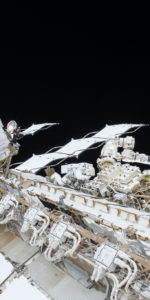

Six hours to go assuming there’s no delay. Let’s all hope for success today.